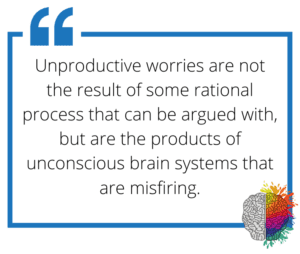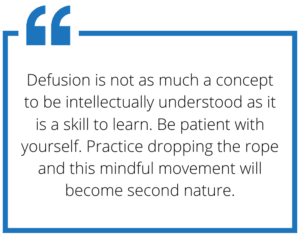Mindfulness and Defusion
A Robot's Guide To Worry Part 3:
Mindfulness and Defusion
Here is Part 3 of our series on worry. In this section, we will discuss cognitive defusion, a powerful, mindfulness-based technique to help you deal with unproductive worries more effectively. The term defusion comes to us from the world of Acceptance and Commitment Therapy (ACT) and Acceptance and Commitment Coaching (ACC). Similar concepts exist in other disciplines under different names. For example, cognitive defusion is related to the Buddhist concepts of “Nonattachment” and “Right Mindfulness.”
Mindfulness
As covered in the previous section of this series, the essence of reframing is to convince yourself that you don’t need to worry. This should usually be your first line of defense. So often, however, despite your clever reframes and convincing argumentation, you will still find yourself worrying. This is where we turn to defusion. Defusion acknowledges that it is difficult to control your thoughts. Frequently, worries are not the result of some rational process that can be argued with, but are the products of unconscious brain systems that are misfiring.
The point of defusion is not to make your worries go away, but rather, this technique acknowledges that sometimes this is impossible and seeks instead to put distance between you and your worries so that they do not have such an impact on your quality-of-life. Though we cannot control or prevent the initial worry from surfacing, we can control how we respond to it. In responding well, we will still have brief appearances of worried thoughts, but we will prevent the sequence from picking up steam and carrying us away.
Defusion is based in mindfulness. The essence of mindfulness is to pay attention to your present moment experience. In the case of worry, to be mindful is to be deliberately aware of your worried thoughts, as opposed to automatically engaging in the assignment and mindlessly advancing the progression of worry. A key part of mindfulness is recognizing that your consciousness and the contents of your consciousness are two separate things. There exists the worried thought, and then separate from that, there is you who observes the thought. Typically, we are not actively aware of this distinction as we move through our day. It feels as though we are our thoughts, and they are us. But this is not the case.
Many of the thoughts that pop into our conscious awareness are the products of unconscious systems. We do not consciously direct these thoughts in the way it seems. To demonstrate this to yourself, try a mindfulness meditation. Set a timer for five minutes, close your eyes, and keep your attention on your breath. You will quickly realize how difficult this is. Despite your best efforts, thoughts will keep popping up, as if pushed from below. Though we do not have as much conscious control over our thoughts as it intuitively seems, we do have a large degree of conscious control over our actions.
To feel as though we are one with our thoughts is our default state, and we refer to this as being fused with our thoughts. Think of two pieces of metal that have been fused together; it’s as if they are one thing.  When we are fused with our thoughts, we tend to accept them at face value. We naturally feel as though they are true, important, and deserving of our attention. This natural state leads the Conscious Thinking System to follow the assignments issued by the Unconscious Supercomputer in an autopilot-like way. We find ourselves getting swept away and lost in our worried thoughts, not fully aware of what we are doing.
When we are fused with our thoughts, we tend to accept them at face value. We naturally feel as though they are true, important, and deserving of our attention. This natural state leads the Conscious Thinking System to follow the assignments issued by the Unconscious Supercomputer in an autopilot-like way. We find ourselves getting swept away and lost in our worried thoughts, not fully aware of what we are doing.
The technique of defusion attempts to create a little separation between us and our thoughts. To do this, we begin by shifting our perspective and observing our thoughts. This mental move into the observer perspective helps us to become actively aware that the thought is just a thought, and not necessarily a directive. This shift creates a gap between stimulus and response and helps us to snap out of the autopilot-like progression. The observer perspective makes us step back and become more mindful of how we are reacting to our thoughts. Let’s now look at the technique in its entirety.
Defusion
There are many different defusion techniques. The one presented here consists of three steps.
Step 1 – Observe the worried thought. Give it a name.
Turn your attention towards the worried thought. Observe it. Here it can be useful to imagine that you have a third eye. This is your mind’s eye. It is this eye that focuses your internal attention. When we are in worry mode, we are working on the assignment issued to us by our Unconscious Supercomputer. Our mind’s eye is focused on the pieces of the problem and is manipulating these in an attempt to help solve it. 
To turn your attention towards the worry itself is to shift your mind’s eye. It is to pull back from inside the problem-solving sequence and take a broader view of what is happening. The key to this shift is to become aware of your thinking as opposed to mindlessly responding to the assignment. When we notice that we are lost in our worried thoughts, we pull back and take on the observer perspective.
It can help to visualize this step. Visualize that your mind’s eye is able to pull back and view your body from the outside. Envision balls of energy that represent your worries swirling around in your head. Or imagine that your worried thoughts are leaves floating down a stream. Visualize them flowing in one side of your head and out the other.
Another way to help solidify this noticing and shift in perspective is to give a name to the worry. For example, you could say to yourself, “Looks like the ‘I will screw this up’ story is popping up again, I’ve heard this one before. Boring.” Alternatively, you can just say a word to yourself like “thinking” or “worrying.” This internal verbalization helps to strengthen the act of noticing and creates separation.
When practicing defusion, we are not trying to make the worried thought go away. We are not fighting with it or struggling to get it out of our heads. Research shows that attempting to do so only perpetuates the thought and makes it more sticky. Rather than attempting to banish it, we are instead shifting our perspective, observing it, and allowing it to be. This puts distance between us and the thought and prevents it from snowballing.
Step 2 – Remind yourself that the thought is a mechanical product.
Once you have actively noticed the unproductive worry and shifted your attention towards it, remind yourself that the thought is just a mechanical product and nothing more. A thought is just a thought. It does not inherently represent truth, nor does it present an imperative to take the assignment and begin problem-solving. The thoughts involved with unproductive worry are simply the outputs of an unconscious brain system that is likely misfiring due to the mismatch between modern circumstances and the environment we were designed for.
This step is important precisely because our thoughts feel inherently true and important. Their appearance is accompanied by an emotion-based desire to engage with them and fulfill the assignment. It is easy for us to follow this autopilot-like guidance as if we are in a trance. To remind ourselves that the thought is a mechanical product, a misfire and nothing more, can help us snap out of it and redirect ourselves.
Step 3 – Employ a defusion metaphor.
Once you have quickly completed the two steps above, it can be helpful to bring to mind a metaphor to help you transition your attention back to the present moment and whatever activity you were previously engaged in before the appearance of the intrusive thought. Metaphors are so powerful because we are designed to understand abstract concepts—such as defusion—by comparing them to ideas that are more concrete. When going through the process of defusion, visualizing a metaphor will help you more fully feel the mental move that you are trying to make. Examples of some defusion metaphors are listed below.
Defusion Metaphor - Drop the Rope
To understand dropping the rope, recall that your natural impulse is to engage with and become wrapped up in a worried thought when it appears. We attempt to resolve the assignment so that we can move on with our busy day. This can take the form of:
Option 1 – Taking the Assignment – Imagining different scenarios that might go wrong or exploring various courses of action that are available to you.
Option 2 – Reframing the Assignment – Trying to convince yourself that you don’t need to worry.
Option 3 – Banishing the Assignment – Actively trying to push the thoughts out of your mind.
Notice that each of these options involves some type of effortful mental action. In each, you struggle in an attempt to deal with the assignment. You struggle to solve the problem, struggle to convince yourself there is no problem, or struggle to push the thoughts away. It is common for us to alternate between these three options in an attempt to satisfy the “itch” of the assignment. However, engaging in these activities will frequently not provide relief and will only serve to perpetuate the cycle of unproductive worry. After you have tried to reframe an unproductive worry to no avail, it is usually better to put up with the itch than to indulge the impulse to scratch it.
To help you resist this impulse, we employ the drop the rope metaphor. When unproductive worry has you wrapped up, imagine that the back-and-forth internal dialogue you engage in when attempting to resolve the assignment is a game of tug-of-war. To drop the rope is to stop trying to win the game. To make this move is to quit struggling and stop our attempts to resolve the assignment; we stop trying to solve, reframe, or banish the worry. Instead, we allow our worries to surface and be present, unchallenged.
But just because we stop struggling does not mean that we are completely passive. Though you cannot control your worried thoughts and cannot prevent them, you can control how you respond to them. Your new mindful response is to defuse: turn your attention towards the worry, label it as a misfire, and think of dropping the rope. Then move on with your day and attempt to engage your mind with the next activity on your schedule.
If the worry returns, repeat the process. And there is a very good chance that it will keep returning. This can be aggravating, but resist the impulse to scratch the itch. Accept and allow each time it surfaces. Often, people will use the defusion technique with the expectation that it will make their worried thoughts go away. If this is your intention, you are not truly accepting; you will find yourself struggling and throwing more fuel on the fire. To accept and allow is counterintuitive, but it is your best option and the way forward.
And remember, just as we are not trying to push the worried thought out, we are no longer trying to convince ourselves that we don’t need to worry. The time for reframing has passed. We are not arguing anymore. The part of you that is issuing this assignment is mechanical and does not listen to reason. Instead of trying to resolve the worry, drop the rope, observe the thought, and move forward with the mindset that you will allow the assignments to surface. They will keep rising up, but you don’t need to take them on.
Defusion is not as much a concept to be intellectually understood as it is a skill to learn. Be patient with yourself. Practice dropping the rope and this mindful movement will become second nature. As you do this more, you will get faster at defusing the worry cycle, and situations that once caused you significant anguish will be downgraded to fleeting annoyance.
Defusion Metaphor - Snow Globe
Our next metaphor builds on the previous and is based on the image of a snow globe. It stems from the idea that all mental states—thoughts, worries, difficult emotions, moods—are in constant flux. Each one appears, runs its course, and disappears all on its own. They come and go like clouds in the sky. A psychologically healthy, well-adjusted individual will experience the full range of emotions, both positive and negative. The negative states will often be accompanied by worries and difficult thoughts. Though it is hard to change these troublesome mental states through force of will, we can take comfort in knowing that they will always pass on their own. Often, the best thing we can do with negative and difficult thoughts is to not get too wrapped up in them and not take them too seriously as they occur. 
The idea is that our minds are like a snow globe, with our thoughts swirling around. When we get caught up in a negative thought storm, our natural reaction is to try and think our way out. We try to solve whatever problem is being presented to us by thinking our way through it. This certainly can be helpful in some instances, but in the case of an unproductive worry, you will find yourself treading the same ground over and over again. When you find this happening, stop trying to think things out or convince yourself of anything. Acknowledge that the thoughts are just thoughts, allow them to be there, and know that nature will run its course; they will clear on their own with time.
Think of a snow globe. If you try to get the snow to stop swirling by moving the globe around in an attempt to manipulate the pieces inside, you will only end up stirring things further. The answer is to stop trying to manipulate the pieces and set the globe down, allowing things to settle naturally. Similarly, by ceasing your attempts to fix your thoughts, things will settle and pass more quickly.
Onward
To summarize, when dealing with a worry that is clearly unproductive, your first line of defense is to reframe it and try to convince yourself that you don’t need to worry. This technique is powerful and will often be all you need. However, if the concern keeps popping up after several attempts to reframe it, it is best to move on to defusion. There is no reason to keep trying to convince a part of your brain that is not listening. To defuse, we go through the following steps:
Step 1 – Observe the worried thought. Give it a name.
Step 2 – Remind yourself that the thought is a mechanical product.
Step 3 – Employ a defusion metaphor. Think of dropping the rope or allowing the snow to settle.
Then move on with your day and engage with the next activity on your schedule. But what about those circumstances where you cannot so clearly label your worries as unproductive? The next two parts of this series will address these situations and provide techniques to help make your time spent worrying more productive.
